Solar System Drawing provides a fascinating artistic journey through the celestial wonders that grace our cosmic neighborhood. Begin by sketching the radiant sun at the center of it all, emanating warmth and light. Progress to the inner planets – Mercury, Venus, Earth, and Mars – each with its own unique characteristics. Pay attention to Earth’s distinctive blue hue and swirling clouds,
- A Guide to Creating Your Solar System Drawing
- Exploring the Planets in Your Solar System Art
- Drawing the Inner Planets with Precision
- Creating Scale in Your Celestial Artwork
- Adding Dwarf Planets to Your Drawing
- Choosing the Right Palette for Your Solar System
- Drawing the Solar System from Different Angles
- Frequently Asked Questions (FAQs)
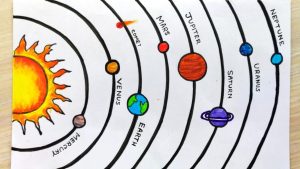
A Guide to Creating Your Solar System Drawing
I’m happy to guide you on your artistic journey to capture the awe-inspiring wonder of the solar system! Whether you’re a seasoned artist or just starting out, here’s a customizable guide to spark your creativity:
Step 1: Setting the Stage
- Pick your canvas: Consider size and medium. Black paper lends drama, while white or colored paper offers flexibility. Graphite for precision, watercolors for ethereal effects, or acrylics for bold colors? Explore!
- Plan your layout: Sketch a light framework. Will it be a close-up of specific planets, a panoramic view, or a stylized interpretation?
Step 2: Bringing the Sun to Life
- Central Star: Draw a warm yellow circle radiating lines for energy. Add subtle shading and texture for depth. You can even experiment with glowing lines or a textured aura.
- Inner Planets: Use smaller circles in varying shades. Mercury – grey, Venus – swirling white and yellow, Earth – blue and green, Mars – reddish brown. Research their unique features for added details.
Step 3: Unveiling the Gas Giants
- Outer Giants: Draw them larger in vibrant colors. Jupiter – orange with red swirls, Saturn – yellow with rings, Uranus – pale turquoise, Neptune – deep blue with streaks. Research their distinctive patterns and add delicate ring structures.
Step 4: Adding Depth and Beauty
- Dwarf Planets and Moons: Include Pluto (greyish), Ceres (brown), and Eris (pinkish) as smaller circles. Around Earth, Mars, and Jupiter, add moons in varying sizes.
- Asteroids and Comets: Sprinkle in small, irregular shapes in grey or brown. For an extra touch, add a streaking comet with a tail of dust and ice.
Step 5: Bringing the Space to Life
- Celestial Background: Fill the space with a deep blue or black, adding subtle gradients for depth. Sprinkle tiny white dots for distant stars. You can even create swirling nebulas or distant galaxies for a cosmic feel.
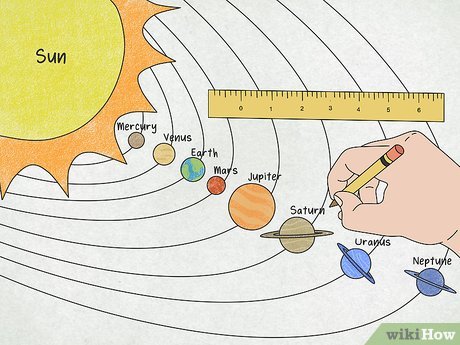
Exploring the Planets in Your Solar System Art
venturing into the planets of your own Solar System Drawing! That’s where the real fun begins! Here are some exciting ways to explore these celestial wonders and make them truly unique:
1. Dive Deeper than Just Sight:
- Feel the Temperature: Imagine strolling on Mercury’s scorching surface or standing in the frigid shadows of Neptune’s craters. Convey these extremes through color, texture, and even the way you depict your characters (shivering figures on Neptune, sweat beads on Mercury).
- Hear the Ambiance: Would Venus’ thick clouds muffle sound into a muffled hum? Would Jupiter’s storms unleash booming thunderclaps? Use sound effects in your artwork or descriptive captions to transport viewers to the heart of your planets.
- Smell the Air: Is it the acrid scent of volcanic gases on Io, the tang of ammonia on Uranus, or the sweet aroma of alien flora on a distant moon? Use evocative vocabulary or subtle visual clues to hint at the olfactory experience of your planets.
2. Let Each Planet Tell a Story:
- Mars – The Lost City: Uncover forgotten Martian ruins bathed in red-orange hues, whispering tales of a long-lost civilization. Imagine wind-swept canyons echoing with the faint sounds of machinery.
- Europa – Alien Ocean: Dive beneath the icy surface of Europa, revealing bioluminescent creatures dancing in the depths. Use swirling blues and greens to portray the alien beauty of this hidden underwater world.
- Pluto – Dwarf with a Heart: Depict Pluto not as a lonely outcast, but as a vibrant celestial body with a heart-shaped feature. Let it pulsate with internal heat, hinting at potential hidden oceans and life forms.
3. Introduce Diverse Inhabitants:
- Titan’s Cloud Creatures: Imagine beings adapted to Titan’s thick atmosphere, floating effortlessly like jellyfish with methane-filled bladders. Show them navigating intricate aerial cities amidst swirling orange clouds.
- Venusian Thermophiles: Let your imagination run wild on Venus! Perhaps heat-resistant creatures cling to volcanic vents, glowing with internal bioluminescence.
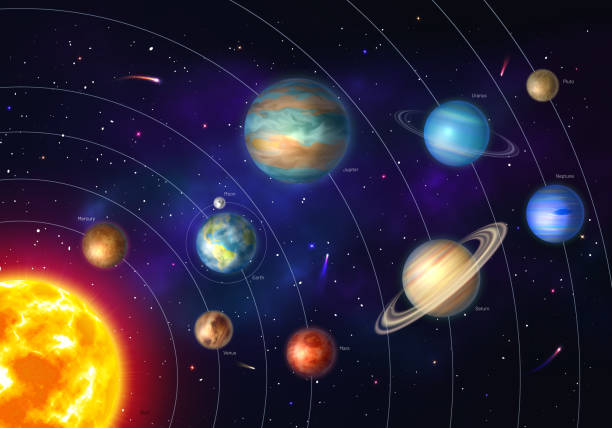
Drawing the Inner Planets with Precision
Capturing the intricate details of the inner planets in your art requires a blend of scientific accuracy and artistic flair. Here’s how to tackle this exciting challenge:
1. Research Like a Scientist:
- Gather Resources: Dive into high-resolution images from space probes, scientific diagrams, and geological data. Study their atmospheres, surface features, and unique characteristics.
- Understand the Differences: Each inner planet has its own story to tell. Mercury’s cratered surface, Venus’ swirling clouds, Earth’s vibrant biosphere, and Mars’ rusty canyons – study their distinct colors, textures, and geological formations.
- Don’t Ignore Scale: Understand the relative sizes and distances between the planets. This will help you create a realistic composition and avoid overcrowding your canvas.
2. Sketch with Precision:
- Light Pencil Touches: Start with light, delicate strokes to build your initial framework. This allows for easy adjustments and avoids smudging on detailed features.
- Accurate Proportions: Use guidelines and measurements to ensure the planets are drawn to scale relative to each other. Reference diagrams can be your best friend here!
- Focus on Key Features: For each planet, identify the most distinguishing features – craters on Mercury, clouds on Venus, oceans and continents on Earth, and volcanoes on Mars. Pay close attention to their shapes, sizes, and arrangements.
3. Shading and Texturing:
- Bring Depth and Dimension: Use shading techniques to highlight mountains, valleys, and atmospheric layers. Cross-hatching, stippling, and blending can add realistic textures to each planet’s surface.
- Capture the Light: Consider the sun’s position and how it casts shadows on each planet. This will add a sense of realism and three-dimensionality to your artwork.
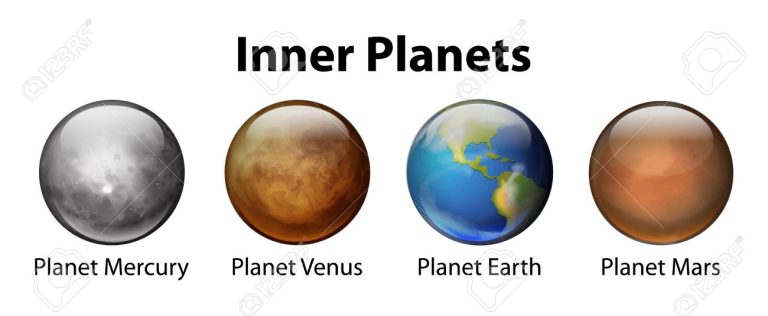
Creating Scale in Your Celestial Artwork
Creating a sense of scale in your celestial artwork is crucial to capturing the awe-inspiring vastness of space. Here are some techniques you can use to make your planets, stars, and galaxies feel truly immense:
Perspective and Composition:
- Foreground and Background: Utilize perspective to establish distance. Place celestial bodies further away behind smaller objects or utilize atmospheric haze to suggest depth.
- Size Variation: Play with the sizes of planets and stars relative to each other. Remember, even a small star can be larger than several planets combined.
- Emphasize Empty Space: Don’t be afraid of blank space! The vast emptiness of space is what makes celestial bodies seem so immense. Fill the majority of your canvas with dark blue or black and sprinkle in stars and planets strategically.
Light and Shadow:
- Light Gradients: Utilize subtle gradients of light across planets and stars, suggesting their immense size and the way light falls across their surfaces.
- Diminutive Lighting: Objects further away should receive less direct light, appearing dimmer and more shadowy. This helps create a sense of depth and distance.
Details and Textures:
- Subtle Features: While adding craters, mountains, or cloud patterns on planets enhances realism, keep them subtle. Overloading details can make planets appear smaller than they are.
- Atmospheric Effects: Utilize subtle haze, swirls, and atmospheric layers to suggest the vastness of gaseous planets like Jupiter or Saturn.
- Deep Space Textures: Add subtle textures and variations in the darkness of space with stardust, faint nebulae, or distant galaxies. This hints at the immense scale of the universe beyond the immediate scene.
Comparisons and Contrasts:
- Familiar Objects: Include a small spacecraft or a silhouette of Earth in your scene to provide a familiar point of reference and highlight the sheer size of celestial bodies.
- Unexpected Juxtapositions: Contrast a massive star with a tiny asteroid or a vast nebula with a lone, isolated planet. This unexpected juxtaposition can emphasize the immense range of scales in space.
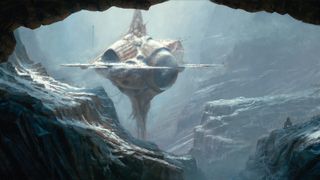
Adding Dwarf Planets to Your Drawing
the often-overlooked gems of our Solar System Drawing – the dwarf planets! Adding these celestial underdogs to your drawing can inject a unique charm and a touch of scientific intrigue. Here are some tips to make them shine:
1. Research their Diverse Personalities:
- Pluto: The iconic underdog, stripped of planet status but full of character. Highlight its heart-shaped surface feature, icy plains, and potential subsurface ocean with shades of red, brown, and white.
- Ceres: The largest dwarf planet, boasting a mysterious dark spot and possibly subsurface water. Depict its cratered surface and volcanic features in shades of grey and brown, with a hint of blue for the potential watery depths.
- Eris: The farthest dwarf planet, shrouded in mystery with a methane ice cap and a potential moon. Capture its icy surface in shades of white and pink,
2. Play with Scale and Perspective:
- Keep them Small but Mighty: Compared to the gas giants, they’re tiny. Place them strategically in your composition, using nearby moons or asteroids for reference.
- Focus on Unique Features: Don’t be afraid to zoom in! Highlight crater patterns, icy plains, or volcanic formations to differentiate them from larger planets.
- Emphasize Distance: Use atmospheric haze or subtle color shifts to suggest their position further out in the Solar System Drawing.
3. Let their Stories Unfold:
- Pluto’s New Horizons Flyby: Depict the spacecraft zipping past the heart-shaped plains, adding a historical touch to your artwork.
- Ceres’ Mysterious Dark Spot: Imagine exploring its depths, revealing icy caverns or even alien life forms. Let your imagination run wild!
Choosing the Right Palette for Your Solar System
Selecting the perfect palette for your Solar System Drawing involves balancing scientific accuracy with artistic expression. Here are some tips to guide your color choices:
1. Grounded in Reality:
- Base Tones: Start with the established colors of each planet. Mercury – grey with reddish hues, Venus – swirling white and yellow, Earth – blue and green oceans, Mars – reddish brown. Research high-resolution images from space probes for precise references.
- Atmospheric Effects: Consider how atmospheres influence color. Venus’ thick clouds add a hazy white sheen, Jupiter’s storms create swirling orange and red bands, and Earth’s thin atmosphere allows vibrant land and ocean colors to shine through.
- Lighting and Shadows: Remember how sunlight affects your chosen colors. Planets closer to the sun will appear brighter, while those further away will be dimmer and have deeper shadows.
2. Artistic Freedom:
- Enhancing Depth: Don’t be afraid to add subtle variations and gradients within your base colors. This adds depth and texture to your planets, highlighting features like mountain ranges or icy plains.
- Creative Interpretation: While accuracy is important, you can add a touch of artistic flair. Experiment with slightly shifting colors, adding glows or atmospheric distortions for a personal touch.
3. Inspiration and References:
- Scientific Diagrams: Use these as a baseline for accurate color representation.
- Space Photography: High-resolution images from space probes offer stunning detail and color inspiration.
- Artistic Interpretations: Look at artwork by professional space artists or fellow enthusiasts. See how they balance accuracy with artistic vision.
4. Experimentation and Refinement:
- Test Swatches: Try out different color combinations on separate paper before committing to your final canvas.
- Layering and Blending: Experiment with layering and blending techniques to create smooth transitions and enhance depth.
- Step Back and Refine: Take breaks and view your artwork from a distance to spot areas that need adjustments or color tweaks.
Drawing the Solar System from Different Angles
Stepping away from the traditional “flat” view of the Solar System Drawing, exploring different angles can inject fresh perspective and dynamism into your artwork! Here are some exciting ways to break free from the usual and capture the cosmic dance from new vantage points:
1. Celestial Close-Ups:
- Dive into Jupiter’s Stormy Heart: Zoom in on the Great Red Spot, swirling with vibrant oranges and reds, lightning crackling amidst the chaotic winds. Show the planet’s swirling bands from within, feeling the immense scale and power of the storm.
- Soar through Saturn’s Rings: Navigate the icy canyons of the rings, showcasing their intricate patterns and subtle color variations. Imagine the awe-inspiring sight of sunlight filtering through the rings, casting long shadows on the planet’s surface.
- Explore the Craters of Mercury: Get up close and personal with the cratered moonscape, highlighting the intricate patterns and textures. Use dramatic shadows to emphasize the harshness of the sun-scorched environment.
2. Unexpected Observers:
- Hitch a Ride on a Comet: Witness the Solar System Drawing from the tail of a streaking comet, feeling the rush of interstellar wind and the dazzling display of dust and ice particles. Capture the vibrant contrast between the comet’s glowing head and the vast darkness of space.
- Peer Through Pluto’s Eyes: Imagine being on the icy surface of Pluto, looking out at the distant sun and the other dwarf planets, feeling the isolation and the subtle beauty of the frozen landscape.
- Become a Moon of Mars: Orbit Phobos or Deimos, the Martian moons, feeling the gravitational pull of the red planet and capturing the desolate beauty of the Martian landscape from a closer perspective.
3. Play with Time and Space:
- Fast-Forward through Seasons: Show Earth’s continents changing colors as seasons shift, the vibrant green of summer transforming into the fiery reds and oranges of autumn. Emphasize the dynamism and life cycles of our planet.
- Look Back in Time: Depict the early solar system with swirling gas clouds condensing into planets, asteroids colliding, and Jupiter’s massive gravity pulling in debris. Capture the chaos and formation of our cosmic home.
Frequently Asked Questions (FAQs)
- Start with simple shapes: Begin by sketching basic shapes like circles, ovals, and rectangles to represent the head, torso, and limbs. This will help you build a foundation for your drawing before adding details.
- Pay attention to proportions: The proportions of a girl’s body are generally different from those of a boy. For example, the head is typically larger in proportion to the body, and the waist is narrower than the hips.
- Oversexualization: Avoid drawing girls in overtly suggestive poses or clothing. Focus on capturing their personality and individuality rather than their physical attributes.
- Clichés and stereotypes: Don’t fall into clichés like damsels in distress or overly bubbly princesses. Be creative and explore diverse representations of girls.
- Art books and tutorials: There are many great books and online tutorials available that can teach you how to draw girls in different styles. Look for resources specifically focused on female figure drawing or character design.
- Online communities: Join online communities or forums for artists who draw girls. This is a great way to get feedback on your work, learn from others, and stay inspired.




















